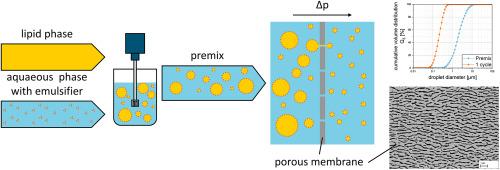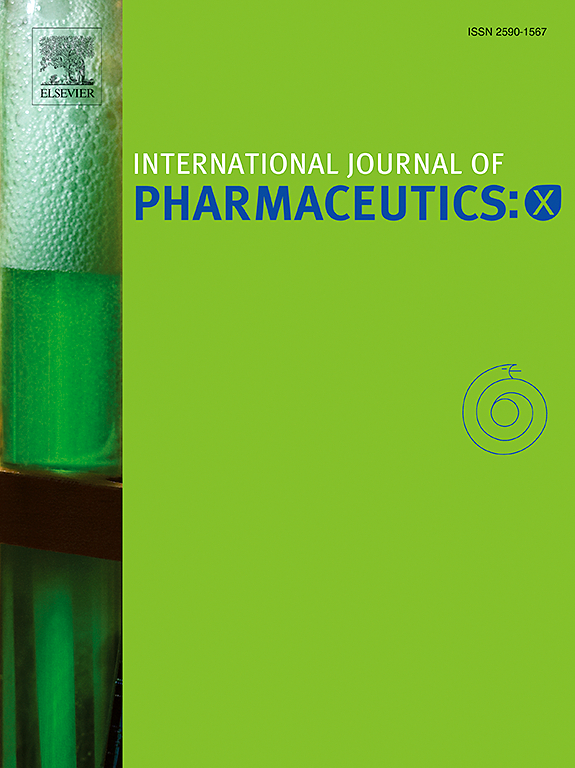探讨镍基高温合金膜的纳米孔结构对乳化性能的影响
IF 6.4
2区 医学
Q1 PHARMACOLOGY & PHARMACY
引用次数: 0
摘要
镍基高温合金制备的纳米孔结构是一种较新的用于预混膜乳化的膜材料,研究还不深入。它们表现出不同于该工艺中通常使用的其他膜的孔隙结构,具有细长的,相互连接的孔隙网络(150 - 400nm)。研究了不同蠕变应变、时间和生产温度对两种不同膜结构在预混合膜乳化中的性能影响。这些膜在一个固定的工艺压力系统中使用,通过压力或乳化循环次数改变比能量输入。此外,还使用了不同制造参数和厚度的膜。两种膜结构在一次乳化循环中均实现了液滴尺寸中位数小于500 nm的单峰分布。结果表明,虽然所有液滴的尺寸都在一个相当的范围内,但孔径仍然起着重要的作用,孔隙越细,液滴越小,但液滴尺寸分布越广,在重复通过后,液滴的进一步破碎程度越低。随着乳化循环次数的增加,更大、更不规则的孔隙显示出进一步破碎液滴的能力,扩大了液滴的分布。研究结果还表明,压力的增加激活了较小的孔隙,这些孔隙在较低压力下似乎仍然不活跃,有利于更多的运输和液滴的破裂。研究结果强调了膜入口的拉伸流动在促进液滴破裂中的关键作用。该研究强化了这样一个理论,即在预混膜乳化中液滴的破裂需要液滴在进入膜时被拉伸,然后在保持这种拉长状态足够长的时间时,由于表面不稳定而自发地破裂,或者由于扭曲通道引起的剪切等机械应力而确定地破裂。本文章由计算机程序翻译,如有差异,请以英文原文为准。

Exploring the influence of the nanoporous structure of nickel-based superalloy membranes on emulsification performance
Nanoporous structures made from nickel-based superalloy are fairly new and not thoroughly studied membrane materials for premix membrane emulsification. They show a different kind of pore structure than other membranes typically used in this process with a network of elongated, interconnected pores (150–400 nm). Two different membrane structures, resulting from different creep strains, times and temperatures during production, were investigated for their performance in premix membrane emulsification. The membranes were used in a system with a fixed process pressure, varying specific energy input via pressure or number of emulsification cycles. Furthermore, membranes with different manufacturing parameters and thicknesses were used. Both membrane structures achieved monomodal droplet size distributions with median droplet sizes under 500 nm in one emulsification cycle. The results indicate that while all droplet sizes fall within a comparable range, the pore sizes still play a significant role, with finer pores resulting in smaller droplets but broader droplet size distribution that showed minimal further breakup after repeated passes. The larger, more irregular pores showed the ability to further breakup droplets with increasing emulsification cycles, broadening their distribution. The findings also suggest that a pressure increase activates smaller pores that seem to remain inactive for emulsification at lower pressures, facilitating more transport and droplets breakup. Results underscore the critical role of elongational flow at the membrane inlet in promoting droplet breakup. This study strengthens the theory that droplet breakup in premix membrane emulsification requires droplets to be stretched as they enter the membrane, then breakup either spontaneously by surface instabilities when remaining in this elongated state for a sufficient time or deterministically by mechanical stresses such as shear caused by a tortuous channel.
求助全文
通过发布文献求助,成功后即可免费获取论文全文。
去求助
来源期刊

International Journal of Pharmaceutics: X
Pharmacology, Toxicology and Pharmaceutics-Pharmaceutical Science
CiteScore
6.60
自引率
0.00%
发文量
32
审稿时长
24 days
期刊介绍:
International Journal of Pharmaceutics: X offers authors with high-quality research who want to publish in a gold open access journal the opportunity to make their work immediately, permanently, and freely accessible.
International Journal of Pharmaceutics: X authors will pay an article publishing charge (APC), have a choice of license options, and retain copyright. Please check the APC here. The journal is indexed in SCOPUS, PUBMED, PMC and DOAJ.
The International Journal of Pharmaceutics is the second most cited journal in the "Pharmacy & Pharmacology" category out of 358 journals, being the true home for pharmaceutical scientists concerned with the physical, chemical and biological properties of devices and delivery systems for drugs, vaccines and biologicals, including their design, manufacture and evaluation. This includes evaluation of the properties of drugs, excipients such as surfactants and polymers and novel materials. The journal has special sections on pharmaceutical nanotechnology and personalized medicines, and publishes research papers, reviews, commentaries and letters to the editor as well as special issues.
 求助内容:
求助内容: 应助结果提醒方式:
应助结果提醒方式:


